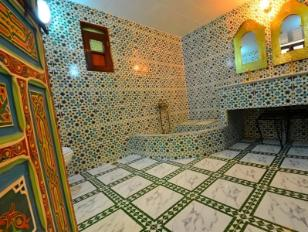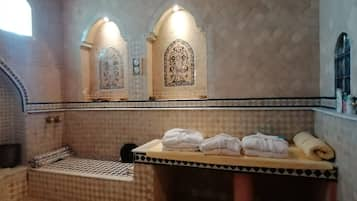- Published on
Unveiling the Sacred Tradition of the Hammam in Moroccan Culture
- Authors

- Name
- Adil ABBADI
Introduction
The Hammam, a centuries-old institution, is an integral part of daily life, social bonding, and cultural heritage in Morocco. This ancient tradition has been passed down through generations, transcending mere physical cleansing to encompass spiritual rejuvenation, social bonding, and a deep sense of community. In this article, we'll explore the cultural context, traditional significance, modern relevance, and preservation efforts surrounding the Hammam, a true Moroccan treasure.

- Cultural Context
- Traditional Significance
- Modern Relevance
- Cultural Preservation
- Conclusion
- Cultural Call-to-Action
Cultural Context
The origins of the Hammam date back to the Roman era, when public baths served as community centers. As Islam spread across North Africa, the concept of ablution (wudu) became an essential part of Muslim life. Over time, the Hammam evolved to incorporate traditional Moroccan elements, such as the use of black soap, exfoliating gloves, and steam rooms. This unique blend of Mediterranean, Arab, and Berber influences has resulted in a distinctive cultural practice that is quintessentially Moroccan.
Traditional Significance
In Moroccan culture, the Hammam is a sacred space where physical and spiritual cleansing converge. The traditional Hammam experience involves a series of rituals, including the application of black soap (beldi soap), vigorous scrubbing with exfoliating gloves (kessa), and a relaxing steam bath. This process not only cleanses the body but also rejuvenates the spirit, fostering a deep sense of relaxation and well-being.
src="/static/images/hammam-interior.jpg" alt="Women gathered in a Hammam, chatting and socializing while enjoying the steam bath" width="300" />
The Hammam also serves as a social hub, particularly for women, who gather to gossip, share stories, and bond over their shared experiences. This communal aspect is a vital component of Moroccan social fabric, fostering a sense of community and togetherness.
Modern Relevance
In today's fast-paced world, the Hammam has adapted to modern needs while maintaining its traditional essence. Many modern Hammams now offer a range of spa treatments, including massages, facials, and aromatherapy, catering to both locals and tourists. This blend of traditional and modern has helped to ensure the Hammam's continued relevance, attracting a new generation of Moroccans and visitors alike.
Cultural Preservation
Efforts are being made to preserve the traditional Hammam experience, with many historic Hammams being restored and refurbished to their former glory. The Moroccan government has also launched initiatives to promote the Hammam as a cultural attraction, encouraging local communities to maintain and develop their Hammams. Additionally, many riads and hotels are incorporating traditional Hammam experiences into their spa offerings, helping to preserve this cultural heritage for future generations.

Conclusion
The Hammam is an integral part of Moroccan cultural heritage, offering a unique blend of physical, spiritual, and social bonding. By preserving and promoting this tradition, we can ensure the continued relevance of this sacred institution, allowing future generations to appreciate its significance and beauty.
Cultural Call-to-Action
As you explore the wonders of Moroccan culture, a visit to a traditional Hammam is an absolute must. Take a step into this sacred space, and let the warmth of the steam, the Hammam's gentle rhythms, and the warmth of the Moroccan people envelop you. Allow yourself to unwind, rejuvenate, and connect with the rich cultural heritage that surrounds you.
